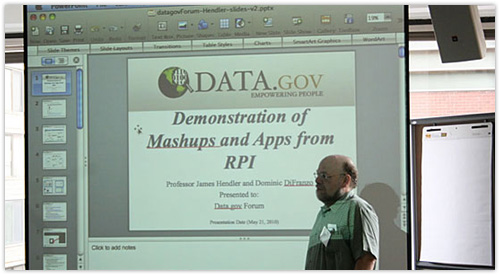Data.gov Mash-A-Thon 1 builds Web 3.0 apps and enthusiasm
A lecture by Professor Jim Hendler at the Data.gov Mash-a-Thon 2010 For two days in August, a classroom in Washington, D.C.'s Dupont Circle filled with Federal developers, students and semantic web experts. They shared one purpose: to create a new generation of "linked-data" applications called "mashups" that use Data.gov's free public data in new and innovative ways.
The U.S. government is in the vanguard of understanding and using the semantic web, which will transform the World Wide Web. Data will "talk" to one another, and make it possible for many activities we do manually today to be done for us automatically. Conference organizers assembled many of the best in the field, including the semantic web's co-inventor, to teach Federal developers how to create mashups with this advanced technology using Data.gov's data.
"What we have here today is a 'Center of Brilliance,'" Data.gov Program Executive Sanjeev "Sonny" Bhagowalia, Deputy Associate Administrator in the U.S. General Services Administration's Office of Citizen Services and Innovative Technologies, told the 30 agency representatives and semantic web experts who participated.
Semantic web expert George Thomas, Enterprise Architect at the Department of Health and Human Services, and Alex Kern of Data.gov's project management office brought in semantic web co-inventor Rensselaer Polytechnic Institute Professor Jim Hendler and his students, who are not only experts in the semantic web but who have created more than 40 apps using the free public data on Data.gov. Hendler and his team provided hands-on training to representatives from 12 Federal agencies.
Participants split into teams, each devoted to building an application from two or more Data.gov datasets by "mashing them up" in thoughtful ways. A "mashup" is a type of application in which two or more datasets are combined to create a meaningful result. (For example, dividing the economic production of a country by its population is a simple mashup to demonstrate productivity per capita.)
In the Mash-A-Thon's two action-packed days, participants developed four mashups, including the Energy Data Mashup highlighted below, which lets people know how much electricity costs in seven cities across the country, and gives them information that can help them save money.
Until Data.gov's birth last year as a single catalog for Federal data, datasets were spread across the Executive Branch, making it challenging to find and bring them together in applications. Data.gov is now a one-stop shop for many of those datasets. "This Mash-A-Thon is a good example of the potential of Data.gov," said participant Susan Turnbull, Senior Program Advisor at the U.S. General Services Administration, which manages Data.gov.
Mash-A-Thon 1 is only the beginning. "Whenever you provide the proper tools to creative and skilled professionals, no one should be surprised by incredible results. This is what the Data.gov Mash-A-Thon did and the results were indeed incredible," said Data.gov Program Director Marion Royal. "I applaud all of the participants and thank them for being a part of this remarkable event. Let's do it again!"

